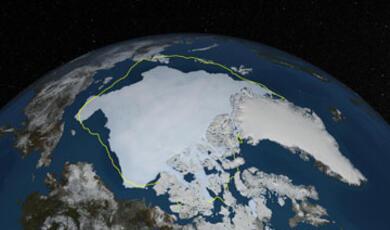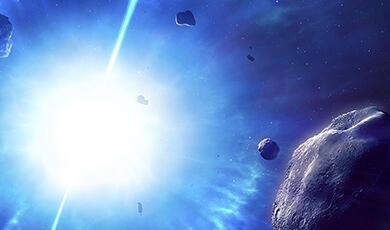Black Holes
Share
- Details
- Text
- Audio
- Downloads
- Extra Reading
Supermassive black holes lurk in the very centres of galaxies. The Milky Way has a central black hole of four million solar masses. Today it is quiescent. But we have reason to believe that millions of years ago it was active. Traces of exploded debris are seen around our galactic centre that arose in a violent explosion some tens of millions of years ago. Most galaxies have massive central black holes, in some cases weighing billions of solar masses. These once were the sites of the most energetic phenomena in the universe, that astronomers recognise as quasars. I will describe feeding the monster within: the rise of the quasars, and how supermassive black holes formed long ago. These immensely luminous objects in the nuclei of galaxies were active when the universe was young. Current data suggests that supermassive black holes formed along with the first galaxies. The ultimate window on building massive black holes is gravity waves, and I will describe gravity wave experiments being planned to search for traces of the formation of such black holes.
Download Text
28 September 2016
Black Holes
Professor Joseph Silk
When massive stars die, they form black holes. Our galaxy is teeming with these stellar remnants. They are observed as matter tidally ripped from a binary companion star pours into the black hole and results in a luminous x-ray source. Most galaxies have massive central black holes, in some cases weighing billions of solar masses. Even the Milky Way has a central massive black hole. These once were the sites of the most energetic phenomena in the universe, that astronomers recognise as quasars. These objects lurking in the cores of galaxies were luminous when the universe was young and gas-rich. Current data suggests that supermassive black holes formed along with the first galaxies. The ultimate window on building black holes is gravity waves. I describe how very recent experiments have directly measured the formation of stellar mass black holes. Proposed gravitational wave experiments will search for traces of the formation of massive black holes in remote galaxies.
Predicting black holes
The theory of general relativity was verified in 1919 when the bending of light rays from background stars by the sun was measured during a total eclipse. But it was only tested in the limit of weak gravitational fields. Einstein predicted that when gravity is strong, a black hole must form. He did not call it a black hole, but it was a region where gravity was so strong that light could not escape. It is bounded by what physicists call a horizon: nothing from within gets out. Matter may shrink into a singularity in the center, but the outside observer would never know. In fact light rays curve strongly as the horizon is approached, rendering a cloak of invisibility at the horizon.
One intriguing historical footnote is that the existence of massive self-gravitating objects so compact that light could not escape was already conjectured on the basis of Newton’s theory of gravity.
The English natural philosopher John Michell wrote in 1783 that:
If the semi-diameter of a sphere of the same density as the Sun were to exceed that of the Sun in the proportion of 500 to 1, a body falling from an infinite height towards it would have acquired at its surface greater velocity than that of light, and consequently supposing light to be attracted by the same force in proportion to its vis inertiae, with other bodies, all light emitted from such a body would be made to return towards it by its own proper gravity.
Michell went on to predict the existence of dark stars and the existence of dark star/ordinary star binaries. A decade later, French mathematician Pierre-Simon Laplace suggested essentially the same idea in Exposition du Système du Monde, published in 1796. Michell and Laplace were far ahead of their time. Dark stars, reincarnated as black holes, were only to resurface nearly two centuries later. Black hole binaries with ordinary stars are the most prominent manifestation of stellar black holes as luminous x-ray sources, and provide robust ways of measuring black hole masses.
Astrophysical black holes
Despite the complete lack of information escaping from a black hole, one can measure the mass of everything inside its horizon. This is what we call the black hole mass.
Most black holes are produced from the deaths of massive stars. These collapse into black holes when their supply of nuclear fuel is exhausted. We measure their masses because there often is a close companion star, whose atmosphere is heated by the gravity of its black hole companion and is tidally pulled into the black hole, emitting prolifically in x-rays.
There are two distinct varieties of black holes: those formed by deaths of stars, in the range of 3 to 100 solar masses, and the supermassive variety at the centers of galaxies, observed to weigh from a million to ten billion solar masses. Supermassive black holes formed long ago in the nuclei of galaxies.
These objects were active and powered quasars when the universe was young. Quasars are the most luminous objects in the universe, yet are highly compact. Current data taken with the world’s largest telescopes suggests that supermassive black holes formed along with the first galaxies.
Prior to 2016, conjecture and inference, based on sound physical reasoning, reinforced our belief in the existence of black holes. But the reasoning was indirect. Firstly, we observed the effects of black holes on their environment, effects for which we had no alternative explanation, such as the vast outpourings of energy by quasars from a region only light years across.
Secondly, we observe objects well above the maximum mass of compact stars, produced by the death and collapse of massive hydrogen-burning stars. Stars of initial mass less than about twenty five solar masses end up as neutron stars. These are made of the most extreme form of matter with the nuclei so compacted together that the stars are essentially at nuclear density. The maximum mass of a neutron star is calculated to be 3 solar masses. The parent stars lose matter by driving winds as they evolve and end their lives as neutron stars. The radius of a solar mass neutron star is about ten kilometers.
Stars that are initially more than about twenty five solar masses cannot eject more than ninety percent of their initial mass. They collapse into compact objects more massive than three solar masses. These must be black holes. Many massive stars are born over the history of the Milky Way, and there are many black holes of stellar origin.
Observing black holes
Einstein predicted the existence of gravitational waves in 1916 as a consequence of his theory of gravitation. A century after their prediction, gravitational waves were finally observed and provided direct evidence for black holes.
The event that shook up physics in 2016 was the discovery of gravitational waves from the merging of two black holes. Einstein predicted this a century ago, but the experiment was remarkably difficult. It required measuring changes in the length of a measuring rod due to the distortion caused by the varying gravity field of a part in 1020 or smaller. The varying gravity field is the passage of a gravity wave from a distant black hole merger.
Gravity waves curve space infinitesimally, but in a time-dependent and directional way, hence the rod suffers an infinitesimal change in length. The effect is tiny because since such events are rare, they must occur far away, typically in galaxies hundreds of millions of light years away.
The experiment designed to measure gravity waves is a laser interferometer, known as LIGO. The measuring rod is the length of the laser beam. It took 40 years for this experiment to succeed. LIGO consists of two perpendicular tunnels, each 4 km long, terminating in mirrors that reflect the laser light. The beams are reflected hundreds of times, so the effective beam length or arm of the interferometer is more like 1000 kilometers. Normally, when the two laser beams converge in the central part of the detector, the troughs and peaks of the waves exactly cancel out. But when a gravity wave passes by, it disturbs the lengths of the two beams by the equivalent of less than a trillionth of the width of a human hair. Because the incidence of the gravity wave is slightly out of phase for the two perpendicular beams, when they are added together a pattern of interference is produced. This was detected.
The signal shows that as the black holes approach the gravity wave frequency rises with increasing intensity and culminates in a final chirp as the two black holes merge. All of this occurs in a millisecond. It was exactly as predicted. The pattern of the signal measures the mass of the black holes: the first detection was a pair of 30 solar mass black holes. From the spacing of the peaks, the distance to the source due to the expansion of the universe can be deduced. The first detection corresponded to a pair of black holes that are a billion light years away.
We are confident of the discovery because there are two different interferometers in the USA, one in the state of Washington and one in Louisiana, that simultaneously saw the same signal. One surprise was the masses of the black holes, which are about twice what had been anticipated. This almost certainly is due to the fact that the two black holes must have taken a long time to merge, perhaps ten billion years, since gravity wave emission is initially very weak when the black holes are far apart.
At this epoch in the universe, the parent stars were almost certainly very underabundant in heavy elements. Chemical evolution of the universe takes many billions of years. Current epoch massive stars lose a lot of mass by stellar winds as they evolve. The winds are largely driven by opacity, which is greatly reduced in the near absence of heavy elements heavier than helium. Hence, current massive stars form lower mass black holes that massive stars in the distant past. And it is these that are the progenitors of the observed black holes.
We have drawn two remarkable conclusions from LIGO, which is continuing to detect more black hole mergers. Black holes exist, and general relativity is confirmed.
Searching for supermassive black holes
The search for supermassive black holes is continuing. When these merge, and mergers are predicted to occur as galaxies merge, the frequency of the gravity waves produced is much lower that for stellar mass black holes. Typically the time-scale for stellar black hole mergers is milliseconds or frequencies of kilohertz. Supermassive black holes merge on a time-scale longer by the ratio of their masses, perhaps 1000 seconds, corresponding to frequencies of a millihertz. Such low frequencies require a laser beam longer by a million, which means one has to go into space. This is exactly the plan for LISA, a space interferometer to be launched by ESA in the 2030-2034 time frame, which consists of 3 satellites with a separation of a million kilometers. The satellites fly in an equilateral triangular formation in a heliocentric orbit about 50 million kilometers from the Earth.
Each satellite contains a test mass whose position is carefully measured. It is one of the apices of the 3-satellite triangle whose sides form the perfect rulers for the gravity wave probe. The test mass must experience zero drag for the experiment to work, that is its path through space must be controlled only by gravity and unaffected by non-gravitational forces such as drag from the impact of the solar wind or radiation pressure from the sun. This is accomplished by placing the test mass in a cavity inside the spacecraft that suffers these forces. The outer shell is repositioned by thrusters every time the spacecraft wobbles because of the nongravitational forces. In this way the cavity, and its enclosed test mass, only feels the gravitational field.
The distance between the satellites is monitored by lasers with the aim of detecting passing gravitational waves. To achieve this goal, LISA must be able to measure relative displacements with a resolution of a billionth of a centimeter, or less than the diameter of an atom, over a distance of a million kilometers.
Theory suggests that there may also be intermediate mass black holes, perhaps of a thousand solar masses. These should be the seeds from which the supermassive black holes form, and are expected to be present in dwarf galaxies. There are already tantalizing indications of their presence from astronomical data. The ideal experiment to study their mergers would also need to be in space but with a typical baseline of 1000 kilometers, to probe frequencies of a hertz. Such an experiment, DECIGO, is being planned by the Japanese space agency.
Meanwhile other ground-based LIGO-like interferometers are being planned. The first of these is already completed, the European VIRGO laser interferometer near Pisa. One in Japan called KAGRA is now under construction. Another in India called INDIGO has recently been approved. With the increased overlapping sky coverage of multiple gravitational wave observatories, it should become possible to greatly reduce the positional uncertainty in the LIGO events, which can currently only be located to within an uncertainty of a few hundred square degrees. One needs much better positional accuracy to look for electromagnetic counterparts of the gravity wave bursts. Theory suggests that there should be gamma ray, optical or radio signals that would help one identify the host galaxy and learn more about the origin of the merging black holes.
Quasars and supermassive black holes
Essentially all galaxies contain central massive black holes. We do not know in any detail how they form, perhaps from the mergers of many stellar black holes, or possibly by swallowing large amounts of interstellar gas that accretes into the centers of galaxies. Black hole captures of stars and gas accretion are aided by the mergers of galaxies that stir up the gravity field and gas angular momentum near the black hole, and facilitate fueling by directing material inwards.
Astronomers observe a correlation between central black hole mass and the total mass of stars in the spheroidal component of galaxies: these latter are the old stars of the galaxy. The disk component of a galaxy contains many young stars and is a recent acquisition.
This has two implications. Firstly, we expect to find massive black holes a few hundred million years after the Big Bang. And indeed black holes as massive as ten billion solar masses are found when the universe was a billion years old. Secondly, we need seeds, smaller black holes, to accrete gas or merge to make the massive ones. If we started from typical stellar black holes, around ten or twenty solar masses, there would not be time enough to grow the monsters we find.
How the seeds are formed is somewhat of a mystery. We believe that they are formed from the first generation of million solar mass clouds formed after the Big Bang. These clouds were chemically pure, no heavy elements had been formed yet in supernovae. This means that cooling occurs by hydrogen atomic excitations. This provides a powerful channel for losing energy, and guarantees that the clouds will undergo direct collapse to form black holes, typically of ten thousand solar masses.
It is these intermediate mass black holes that undergo catastrophic accretion as dwarf mass halos merge to eventually form supermassive black holes in massive galaxies. Every galaxy most likely has a lurking giant in its center.
Supermassive black holes, mostly inactive today, were hyperactive long ago. We see very massive black holes in the early universe. They are quasars and visible because they accrete interstellar gas. The gas heats up and glows in x-rays as the black hole is fuelled and grows in mass. The mass doubling time for a typical massive black hole is about fifty million years. Quasar eruptions continue sporadically as gas clouds are captured by and feed the central supermassive black hole.
Most massive elliptical galaxies today are indeed red and dead. All contain massive central black holes. Because of the paucity of interstellar gas, these black holes are not being fed and are not active. Occasionally there is a merger, most typically with a small galaxy. If this contains gas, some of this will fall into the black hole and drive a new phase of activity.
Black holes become reactivated only when fresh gaseous fuel is provided..
Supermassive black holes at the centers of galaxies are dormant giants. They were active in their youth, long ago.
These events succeed in clearing out the interstellar medium in the host galaxy. Star formation in the forming galaxy was quenched. The radiation from the central black hole limited the amount of infalling gas that fragmented into stars. Long ago, galaxies formed stars prolifically, while today most massive galaxies are red and dead. Red because there are only old stars, and old stars are cool and hence red. Dead because young stars are not forming in the absence of molecular gas clouds.
Black holes cannot become too obese. If the black hole were to get any more massive, the gas is mostly blasted away, thereby maintain a universal ratio of black hole to stellar mass. Remarkably, we observe such a relation from the smallest to the most massive galaxies, telling us that old stars and central black holes self-regulate and formed early in the history of galaxies. The quasar energy release regulates the limiting black hole mass.
Black hole activity can be a dramatic event. We occasionally see powerful jets of plasma that drive giant radio-emitting lobes. The radio jets are thought to be produced in the black hole ergosphere by release of energy arising from the rotation and winding-up of magnetic fields. The supermassive black hole acts like a gigantic flywheel, with the spin of space providing the momentum.
Magnetic fields play an important role. They are responsible for the radio emission that highlights the jets. Gripping the flywheel is presumably done with powerful magnetic fields, thought to be omnipresent. The fields initially have a dipole pattern but soon tangle up because of the differential spin and turbulence. Magnetic reconnection releases huge amounts of energy that is initially channeled along the axis of rotation, emerging as a collimated jet for thousands of parsecs.
A massive black hole lurks in the center of our own galaxy. The Milky Way black hole is located in the constellation of Sagittarius. Studies of orbiting stars allowed a precise mass determination. The stars can be directly resolved in our galactic center at infrared wavelengths, and their orbital motions and speeds around the black hole have been followed for more than a decade. The massive black hole at the center of our galaxy weighs 4 million solar masses.
Our massive black hole is a bright source of radio waves, one of the brightest in the sky, hence its name Sagittarius A. Despite the radio emission, it is not very active today. The x-ray emission from Sagittarius A is very low, and we infer that it is currently lacking fuel, accreting very little gas from its surroundings. But in the past, the situation was very different and Sagittarius A has experienced outbursts of violent activity. About 10 million years ago, a giant explosion occurred that left traces in the gamma ray sky. The Fermi gamma ray satellite telescope image has revealed twin bubbles of gamma ray emission hundreds of light years in extent that attest to the violence of this explosion.
New observations with instruments such as the ALMA radio interferometer, now taking data at high angular resolution in Chile, and the James Webb Space Telescope, to be launched in 2018 and able to take exquisite images in the near infrared, will eventually elucidate the growth and evolution of quasars. However the ultimate window on building and observing massive black holes is gravitational waves. These are emitted as supermassive black holes orbit each other and eventually merge. This will provide the ultimate proof of the existence of supermassive black holes. But perhaps not until the launch of eLISA in 2034.
© Professor Joseph Silk, 2016
This event was on Wed, 28 Sep 2016
Support Gresham
Gresham College has offered an outstanding education to the public free of charge for over 400 years. Today, Gresham College plays an important role in fostering a love of learning and a greater understanding of ourselves and the world around us. Your donation will help to widen our reach and to broaden our audience, allowing more people to benefit from a high-quality education from some of the brightest minds.


 Login
Login







